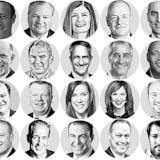In August 2021, the Minnesota Twins appointed Meka White Morris as their senior vice president and chief revenue officer, a new position designed to drive business growth and development for the Major League Baseball organization.
She's also focused on exploring and building new revenue streams for the Twins.
At the top of the list of new revenue stream: selling sponsored jersey patches on player uniforms. Other professional American sports leagues, including the Wild and Lynx, have already allowed this, paving the way for millions of dollars in added revenue for teams. Major League Baseball finally made the decision earlier this year, ruling teams can place sponsored jersey patches on player uniforms starting in the 2023 season.
Earlier this year, MLB's San Diego Padres signed a four-year jersey patch deal with Motorola reportedly worth $9 million per year, a nice-sized check for a team that was $32 million in the red for its operating income during the 2021 season, according to Forbes. The Twins, meanwhile, had operating income of $10 million on $268 million in sales revenue that year.
We recently spoke with Morris, who previously was chief revenue officer for U.K.-based Tappit, a fin-tech firm that works with stadiums and event venues, about the jersey patch opportunity and other revenue-generating opportunities for the baseball team. The interview has been edited for length and clarity.
Q: What are the Twins looking for in a jersey logo partner, and why is this seen as a major opportunity for the franchise?
A: It's arguably one of the highest and most visible exposure opportunities that you can have in sports, outside of, or adjacent to the name of a building. Every time a player shows up on camera, whether in the community or otherwise, this partnership will be on display at some level. While the monetization of this opportunity is important, it isn't more important that ensuring we're connected with a brand that has the same brand values as we do and wants to do more than gain exposure and impressions, but actually link arms and do something that changes and impacts a community we both serve.
Q: Some MLB teams are selling logo space on the baseball field. How are conversations going with companies that want to stich their names into the grass at Target Field?


